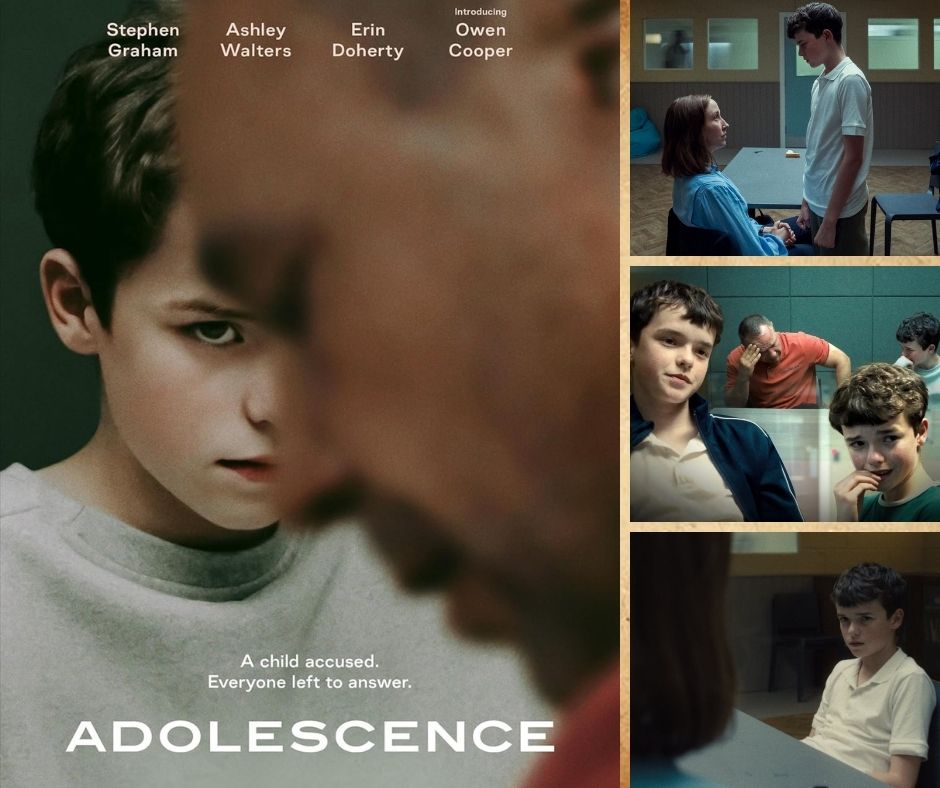Adolescence
What would lead a 13-year-old to commit murder?

After achieving great success with the similarly one-take (and excellent) Boiling Point, director Philip Barantini reunites with Stephen Graham for Adolescence, a four-part Netflix series created by Jack Thorne (Enola Holmes) and Graham himself. The show follows the Miller family as their 13-year-old son, Jamie, is arrested for the murder of his classmate, Katie. Each episode is a single, unbroken hour-long take—designed to bring the audience closer to the emotional and psychological ripple effects of the crime.
It’s a bold approach that completely serves its purpose, never distracting from the storytelling—unlike last year’s Nickel Boys, where the approach sometimes pulled focus. In fact, it enhances the material. The format brings us closer to these characters and forces us to witness moments that would normally be skipped or glossed over: the silence, the waiting, the awkwardness, and—most importantly—the slow build-up of anger that leads to breakdowns. There are occasional ‘showy’ moments, but they don’t pull viewers out of the experience (though, do yourself a favor and look up how the drone shot that closes Episode 2 was filmed).
Most stories about a crime like this would focus on courtroom twists, flashbacks, and final revelations. But Adolescence bravely reveals the “what” early on, and instead spends its time exploring the world that shaped these characters—school life, family dynamics, emotional blind spots. Like the psychologist, the series isn’t concerned with showing us exactly what happened, but rather with understanding Jamie’s understanding of what happened. Episodes 2 and 4 are dedicated to situating us in that world, but no episode sheds more light than Episode 3.
There’s no question that Episode 3, centered around Jamie’s session with a psychologist, is the series’ standout. First-time actor Owen Cooper goes toe-to-toe with Erin Doherty in an emotional standoff that slowly unravels Jamie’s psyche. Throughout the episode, we watch both characters test each other’s limits. The sharp intelligence of the script is matched by two terrific performances and razor-focused direction. It all culminates in a fantastic climax—Jamie takes a confident bite of his sandwich, thinking he’s won, only to be disarmed by a psychologist who’s seen through every move. It’s unforgettable television—likely one of 2025’s most talked-about scenes.
True to its title, the series is ultimately about modern adolescence, exploring themes like loneliness, peer pressure, and online radicalization with a striking sense of authenticity. It also shines a light on the darker corners of the internet—highlighting the growing influence of incel culture and figures like Andrew Tate—and how these forces shape society in ways that often go unnoticed until it’s too late. A small but clever scene, where a police officer misreads a message because of emoji use, quietly shows how out of sync the adult world can be with the digital lives of teenagers.
That said, when the series reaches Episode 4, most of the major revelations have already landed. The final chapter—focused more on the aftermath and how the family copes—is the only one where the real-time format starts to feel a bit long. There’s a pivotal car scene that hits hard, but overall, the episode might’ve worked better trimmed down. Still, it gives Stephen Graham his big moments, and it’s the kind of performance that screams Emmy nomination—and possibly a win.
In the end, Adolescence is a fascinating and emotionally gripping watch that you’ll likely binge straight through. If you’re used to Netflix stretching every plot thread into a ten-episode arc, this might feel brisk or even incomplete at first—but taking a step back, it’s remarkable how much depth the creative team packs into just four hours. Everything essential is here, culminating in that extraordinary third episode, which brings us closer than ever to understanding how a boy—born and raised in a seemingly normal family—could commit such a horrifying act. The one-take format isn’t just a stylistic flourish; it draws us into the rooms, the silences, and the unspeakable truths that most stories are too afraid to sit with.